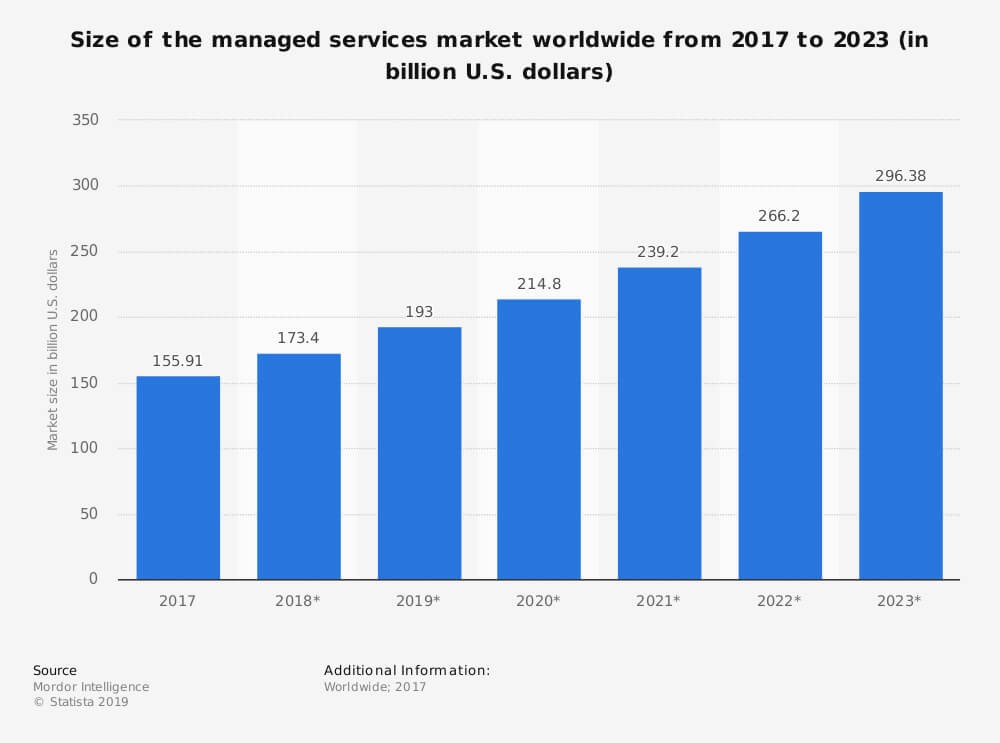Article The Future of Managed IT Services: A Growing Trend
Enterprises striving to achieve digital transformation are finding themselves mired in a complex web of challenges that interconnect the employee experience and the future of the business.
By Debbie Malone / 15 May 2019 / Topics: Modern workplace

Attracting and retaining top talent is a growing concern across industries, leading companies to invest more in technologies that enhance workforce engagement and satisfaction. According to “The 2019 State of IT” Spiceworks report, end-user needs are a top driver for 57% of new hardware, software and service purchases made by North American businesses.
That’s because today’s employees expect their devices to deliver a consumer-like experience that mirrors how they interact with technology in their personal lives. For a business to successfully achieve this outcome — and support delivery of the one-of-a-kind, boutique experiences consumers crave — its workforce needs the ability to work from anywhere, on any device and operating system, at any time.
Expanding IT responsibility
But the struggle to achieve these goals is changing the role of IT within the organization. Technology outcomes are more closely tied to business outcomes. And now, every employee is connected in some way — placing higher demands on IT teams and infrastructure. These demands can take a heavy toll, leaving IT organizations strapped for time and resources.
Nowhere is this strain more apparent than at enterprises supporting a heterogeneous mix of new and legacy environments. In many of these organizations, the anywhere-anytime workforce has become the norm, tying a diverse and growing number of devices to the network.
Any single point of failure can quickly become a security liability, derail employee productivity or sour the customer experience if not promptly identified and resolved. Because of this, simply maintaining day-to-day operations can significantly detract from more innovative or strategic business objectives.
Yet, according to the “Tech Trends 2019” report from Deloitte, “There is an increasingly critical need to reorient technology teams around product and business outcomes, shifting effort and resources away from rote, repetitive, low-value activities that dominate energies in many IT organizations.”
IT leaders agree. The “2019 CIO Survey Report” by Grant Thornton found that 81% of Chief Information Officers (CIOs) say the role of IT is to “drive innovation or modernization programs.”1
The report concludes, “Today’s CIOs understand that the role of the IT organization is more than a back-office cost center, responsible for keeping systems running and reporting run times. IT organizations are a critical component of developing and executing business strategy.”
How managed service providers fill the gaps
As CIOs and IT organizations become more focused on strategic business initiatives, IT leaders are looking for ways to make their resources stretch much further to continue meeting everyday operational needs. That’s leading to a big shift in how enterprises manage workplace technology.
Rather than relying solely on internal teams, more organizations are turning to Managed Service Providers (MSPs) to handle routine IT tasks. MSPs can supplement IT operational processes such as procurement, device and license provisioning, end-user support, systems management, security, and end-of-lifecycle disposal and refresh.
Adoption of these managed workplace services is on the rise. A study by Mordor Intelligence predicts the global MSP market will grow from $193 billion in 2019 to $296 billion in 2023 (see Figure 1).

As organizations strive to update legacy infrastructure, improve the employee experience, enhance product and service offerings, and innovate consumer touchpoints, they’re also re-evaluating which IT needs can be outsourced. Partnering with a third party can increase business agility and refocus internal IT resources on the tasks most crucial to achieving an ideal future state.
According to the “Future of Outsourcing” report by Raconteur, top reasons businesses worldwide are relying more heavily on IT outsourcing include:
- Freeing resources to focus on core business (49%)
- Providing access to skills not available in-house (46%)
- Reducing costs (45%)
- Improving flexibility in the use of resources (39%)
- Improving the ability to innovate (15%)
Managed IT services support business agility.
Managed workplace services encompass a broad spectrum of IT support services delivered by MSPs to complement an organization’s internal IT capabilities. In addition to everyday IT needs, other compelling delivery models can include on-site deskside support or 24/7 remote end-user support, user-centric device and application provisioning, walk-up centers and IT vending machines, and more.
Ultimately, what most of these IT outsourcing services have in common is they’re designed to help employees stay productive and to create a more positive experience with workplace technology.
For instance, end-user support services can handle the kinds of minor hiccups that typically crop up in a large workforce — and overwhelm IT teams with help requests. Preconfigured or cloud-provisioned devices enable employees to hit the ground running with company-issued smartphones or laptops, without having to waste time on app installation and setup.
And self-service support models empower employees to take charge of getting the help they need, when they need it, without having to open a service desk ticket and wait.
The bigger the business, the more important it becomes to drive this kind of efficiency. According to the Spiceworks report, enterprises with 1,000 to 4,999 employees plan to allocate 17% of their annual IT budget to managed services, while organizations with 5,000 employees or more will allocate 22% on average.
These services enable businesses to reap the full productivity benefits of workplace technology because work doesn’t have to come to a halt whenever something goes awry. And IT teams can focus on critical business needs rather than having their time taken up with minor tasks — such as installing an application on a newly hired employee’s laptop.
Even in the digital age, an organization must be true to the core of its business to survive. While technology is integral to a modern enterprise, managing IT needs should never detract from the businesses’s strategic goals and objectives.
The value of keeping internal IT teams free to focus on crucial, future-forward initiatives can’t be understated. In an age where this can make or break a business, it’s more imperative than ever to embrace agile models of IT service delivery.
Empower a more productive workforce. We’ll free your IT teams to focus on what matters by implementing self-service and automated support solutions.
1 Grant Thornton. (2019, Feb. 26). 2019 CIO Survey.







